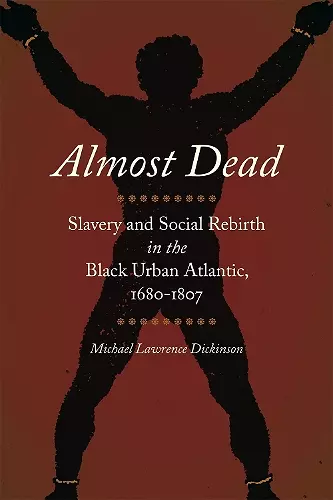Almost Dead
Slavery and Social Rebirth in the Black Urban Atlantic, 1680-1807
Michael Lawrence Dickinson author
Format:Hardback
Publisher:University of Georgia Press
Published:1st May '22
Should be back in stock very soon

How the Urban Atlantic shaped and was shaped by Black lives
Beginning in the late seventeenth century and concluding with the abolition of the Atlantic slave trade, Almost Dead reveals how the thousands of captives who lived, bled, and resisted in the Black Urban Atlantic survived to form dynamic communities.
Beginning in the late seventeenth century and concluding with the abolition of the Atlantic slave trade, Almost Dead reveals how the thousands of captives who lived, bled, and resisted in the Black Urban Atlantic survived to form dynamic communities.
Michael Lawrence Dickinson uses cities with close commercial ties to shed light on similarities, variations, and linkages between urban Atlantic slave communities in mainland America and the Caribbean. The study adopts the perspectives of those enslaved to reveal that, in the eyes of the enslaved, the distinctions were often of degree rather than kind as cities throughout the Black Urban Atlantic remained spaces for Black oppression and resilience. The tenets of subjugation remained all too similar, as did captives’ need to stave off social death and hold on to their humanity. Almost Dead argues that urban environments provided unique barriers to and avenues for social rebirth: the process by which African-descended peoples reconstructed their lives individually and collectively after forced exportation from West Africa. This was an active process of cultural remembrance, continued resistance, and communal survival. It was in these urban slave communities—within the connections between neighbors and kinfolk—that the enslaved found the physical and psychological resources necessary to endure the seemingly unendurable. Whether sites of first arrival, commodification, sale, short-term captivity, or lifetime enslavement, the urban Atlantic shaped and was shaped by Black lives.
Provocative, wide ranging, and original, Almost Dead reveals Black people’s efforts to survive in a world of slavery. Deeply sensitive to enslaved people’s own voices, perspectives, and experiences, Michael Dickinson’s moving account of existential violence and resilience transforms our understanding of enslavement, social death, and social life.
* author of Surviving Slavery in the British Caribbean *Based on new archival research as well as a broad re-examination of classic slave narratives, Almost Dead offers a compelling reconceptualization of Black life across the Atlantic world.
* author of Abolitionism: A Very Short Introduction *Dickinson has written an impressive book that is moving at times, with excellent prose and penetrating insights, that reads more like an extended essay in its elegance.
* coeditor of The Urban Black Atlantic during the Era of the Slave Trade *With a brave and masterful handling of sources, Michael Lawrence Dickinson moves beyond the bodily trauma of slavery in the Black Urban Atlantic and dives directly into the souls of his subjects. Almost Dead is a deeply moving and important work that centers the power of Black survival and rebirth in the early Anglo-Atlantic world.
* author of Never Caught: The Washingtons’ Relentless Pursuit of Their Runaway Slave, Ona Judge *Dickinson has written a carefully constructed book that should garner a wide readership among scholars of slavery in the Atlantic world and those interested in the origins of Black urban life in North America.
* Society for U.S. Intellectual History *The first-person recollections of life in bondage are indeed indispensable, and in Dickinson’s hands, they open us up to new understandings of the unique possibilities of urban slavery. In vibrant narrative prose, Dickinson offers an immersive description not only of three Anglo-Atlantic cities but also of a wider Anglo-Atlantic world. He is both sensitive to the extraordinary pain and suffering of that world and penetrating in his ability to find resilience, continuity, and social rebirth within it. This is Almost Dead at its best: a model of careful, sustained attention to the thoughts, feelings, and emotions of the enslaved, through which Dickinson gives us a balanced examination of the dislocations of captivity alongside the place-making agency of captives. For this, it will serve as an important touchstone for scholars of slavery and diaspora in the Atlantic world and their undergraduate and graduate students.
* H-Net Reviews *Dickinson's focus on the relationship between the Caribbean ports of Bridgetown and Kingston and the mainland port of Philadelphia illustrates the powerful trade and cultural connections between these urban areas and their denizens that has not been highlighted in previous works. Also, his attention to social rebirth refocuses the narrative in a way that places the agency of bondspeople at the forefront. Dependent upon records such as slave narratives, advertisements, legislation, and enslavers' records, Dickinson draws out the thoughts and emotions of the individuals involved, thereby holding the reader's interest. Scholars of Atlantic history will find the book both compelling and enlightening, as will those who are just beginning to investigate this dark era in American history.
* The Journal of American HistoISBN: 9780820362250
Dimensions: unknown
Weight: unknown
216 pages